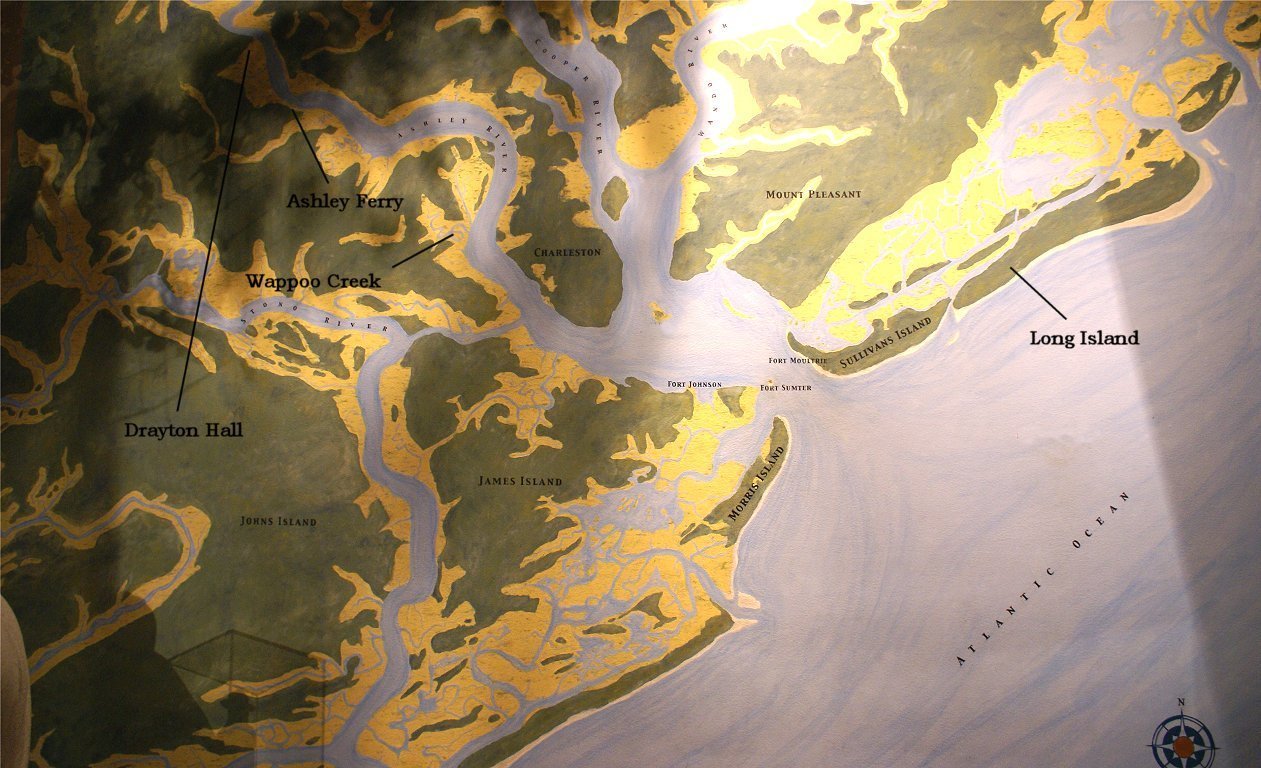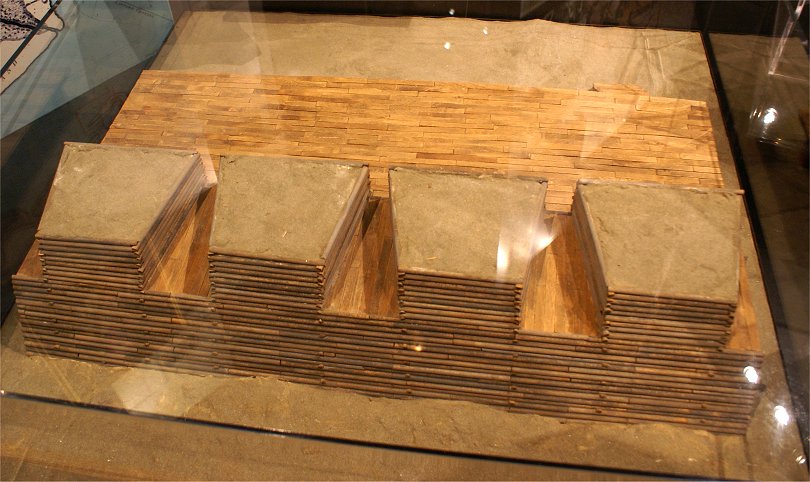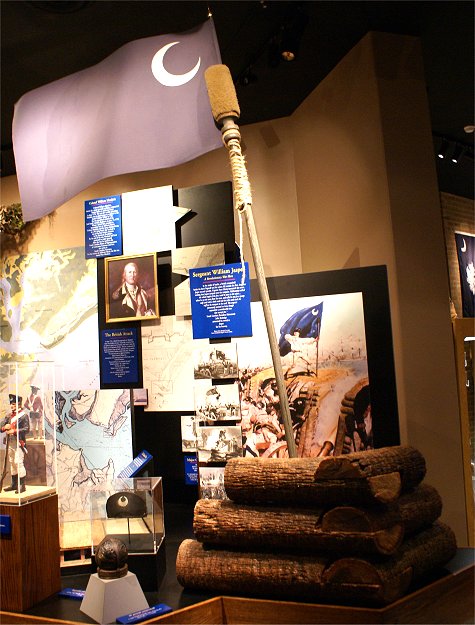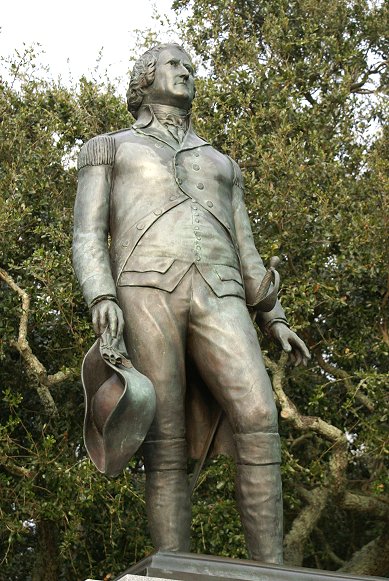Charleston
June 28, 1776
In the summer of 1775, with their main army besieged at Boston, the
British began planning an expedition to the South, believing that a
show of force by regulars might encourage the Loyalists to rise up and
restore the crown to power. The overly optimistic plan, influenced
by the deposed Southern governors, envisioned bringing the four
Southern colonies back in line and allowing many of the British troops to
return north. On January 20th, 1776, Sir Henry Clinton set sail
from Boston with 1,200 to 1,500 men. They would sail to Cape
Fear off North Carolina and rendezous with a fleet under Peter
Parker escorting an expedition under General Cornwallis. After a stop
in New York harbor, Clinton arrived off Cape Fear on March 12th.
There he learned that his hoped for Loyalist support had
been defeated the day he left New
York Harbor, February 27th, at Moore's Creek Bridge, in a fight sometimes known as the 'Battle of Slippery Logs'.
Parker's ships with Cornwallis only started arriving on April
18th, and it was late May before the last ships arrived.
With the Loyalists crushed, the original British
plan was no longer workable, but perhaps something useful could
be done. Clinton suggested setting up posts in Virginia, but
Parker talked him into capturing Ft Sullivan protecting Charleston.
The fort was incomplete, and once it was
captured, it might be held with a small force.

The fort, since renamed Fort Moultrie after its
commander, held up to
25 guns facing the entrance to Charleston harbor. Between
Sullivan's Island and James Island was a dangerous shoal.
(Ft Sumter would be built on it many years later.) A
small channel did exist between the shoal and James Island, but it was
too treacherous to use. Charles Lee, when he arrived to take
command of the American defenses, was not happy with the preparations
so far. The fort had little protection to its rear, with only
a seven foot tall wall and a few guns. With no bridge to the
mainland, there was easy way to retreat. Lee ordered a
floating bridge constructed, but the resulting structure was too weak
for the troops to use. Three miles east of the fort was
undefended Long Island, separated from Sullivan's Island by
Breach Inlet. Although Sullivan's Island at Breach Inlet was
defended, a British force
might use Long Island (now the Isle of Palms) as a springboard to the
mainland and isolate Fort Moultrie. This is exactly what
Clinton planned - eventually.

View From Ft Sumter, Then Shoals

Breach Inlet
On June 16th, Clinton landed roughly 2,500 men on
Long Island, visible at the other end of the modern bridge.
Trying to cross Breach Inlet in boats to Sullivan's Island, boats
would ground in a foot and a half of water, but when men would get out
to push, they would find the water to be seven feet deep. With
such uneven footing and with American troops defending the landing
area, the crossing was called off. Parker felt that a naval
bombarment would neutralize the fort, and if he could get ships past
the fort, he could cover Clinton's troops as they crossed over to the
mainland to cut off retreat from Sullivan's Island.


Contrary winds pushed back Parker's attack until
late morning on June 28th, giving the Americans more time to prepare.
A bomb ketch started the bombardment with 10 inch mortars at a
mile and a half. Four ships approached to around 400 yards
and opened fire. They were joined by three ships in a second
line further behind. Around 100 guns fired on the fort for around
an hour. The British mortar bombs were generally absorbed in
swampy or sandy soil, and the cannon balls were absorbed by the sandy
soil behind the fort's palmetto walls, wich didn't splinter like other
woods. The three ships of the second line were to pass into the
harbor and around the fort, firing into its flank and rear and allowing
Clinton's men to cross to the mainland. All three ships ran
aground in the middle shoal, though, removing their guns from the fight
and preventing Clinton's crossing to the mainland. Essentially,
this sealed American victory. One of the grounded ships was
abandoned and destroyed while the other two were withdrawn
for repair.

During the bombardment, a British shot
shattered the flagpole, which fell outside the fort along with the
flag. The flag coming down was considered a sign of surrender, so
a Sgt. Jasper climbed the wall to the other side and erected the flag
again with an improvised pole.

Statue of Col. Moultrie in Charleston
The fighting ended at dark, with the British fleet
withdrawing with the tide. Col Moultrie and his men
had dished out significant punishment to the British fleet,
concentrating much of their fire on Parker's flagship, the Bristol,
which took 70 hits and lost 64 dead and 161 wounded. Parker
himself was slightly wounded. American losses were
relatively light, 10 killed and 22 wounded.
Clinton remained on Long Island for three
weeks, then withdrew with the fleet to New York City, where they
participated in Sir William Howe's campaign. The expedition had
been an embarrassing fiasco. The South remained fully in
patriot hands until Savannah was captured in the final days of 1778.
Charleston was captured only in the summer of 1780,
setting off fighting in both Carolinas and Virginia. Although
the South was spared for much of the war, ultimately the war would
be decided there.






